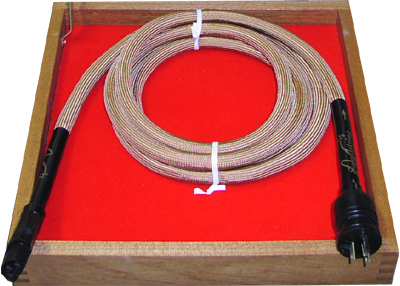You are reading the older HTML site
Positive Feedback ISSUE 8
august/september 2003
soundstring cable technologies
AC Power Cables, Part 1
as reviewed by Robert H. Levi

ROBERT H. LEVI'S SYSTEM LOUDSPEAKERS ELECTRONICS SOURCES CABLES ACCESSORIES
|
It all started at the Home Entertainment Show in San Francisco in June. After discovering the wonderful-sounding Dynaudio Temptation/Musical Fidelity/Tara suite, I presumed I had found the Best of Show. From that moment on, other suites paled by comparison. It was Saturday afternoon before I wandered into a smallish room—say 15 by 15 feet—featuring the Wisdom 75 speakers with Wisdom electronics (a re-badged Accuphase preamplifier and SACD/CD player plus Wisdom's own amplifiers), and sonics to die for. It was a tie for Best of Show, and more importantly, it was the debut of Soundstring cables.
Although Lion Cable, Soundstring's parent company, has been around for over fifty years as an OEM manufacturer, Soundstring is the new cable kid on the block. The Wisdom system was entirely wired with their products, and while I have heard the fine Wisdom speakers many times, this was the best yet. Never, and I mean never, have I heard such smoothness without loss of definition or musical punch. Wisdom did not make any extraordinary claims. They merely said that their speakers had been maximized with excellent electronics and a new brand of wire that they not only recommended, but would supply to all future buyers of their speakers.
The Soundstrings are different in several ways. Only one model (the best they can make) is offered, as power cable, interconnect, or speaker cable. The cost is $575 for the 6-foot power cord, $419 for the one-meter interconnect, and $575 for the 6-foot speaker cable. This is a hell of a deal IF they also challenge the state of the art. I reasoned that if they were in part responsible for the marvelous Wisdom sound, I was witnessing a breakthrough in cable technology. I will be examining the power cords in this review, and the interconnects and speaker cables in a future review.
The patented technology incorporated within these cables is extensive. The finish is beautiful. The "Tricormaxial" cables are constructed in a dual three-conductor "Progressive Geometric Gauge" design. Each conductor is individually insulated with flame-retardant PVC. The jacket is covered in premium grade, abrasion resistant, tightly woven Nylon multi-filament in a copper color. The "Progressive Geometric Gauge" design enables all signals and frequencies to independently seek the path of least resistance. This is claimed to achieve neutrality, eliminate time smear, and yield universal application in any system. The wire is made of 99.9999% pure, oxygen-free copper in a finely stranded ropelay pattern. Each of the three legs is 10.5 gauge, which is very beefy, but the cable is surprisingly flexible. The power cords are rated for 20 amplifiers/300 volts. The capacitance is 47pf/ft (the audio cables are 36pf/ft). This is serious looking cable, with fit and finish a cut above much more expensive cables on today's market.
All I changed were the power cords, leaving my Kimber Select interconnects as is. The first changes were the cords to the two Pass X600 power amplifiers, replacing the Tara Decades ($750 each) with the Soundstrings ($475 each). The system sounded richer, textures were enhanced, and the bass was bolder. The amplifiers also sounded more powerful, so I cut the volume back one dB to match levels. The changes were not subtle. I then took two power cords over to Mark Katz's home to try with his 100-watt Kora tube amplifiers, to check compatibility. He had Tiff power cords ($250 each). The results were similar. The Kora monoblocks sounded more powerful, and the soundstaging was enhanced. Neither my Pass solid state amplifiers nor Mark's Kora tube amplifiers were in any way shortchanged by the Soundstrings. Returning to the Tara cables on my amplifiers was a disappointment, so to double check, I replaced the Taras with good-quality 14-gauge power cords, made in China and provided by many manufacturers with their equipment. The sound stage shrank, air and ambience were reduced dramatically, and bass was truncated. Those original equipment cords were truly expendable.
Next to be replaced was the Kimber 10 Gold ($350) from the wall to the Power Wing (from World Power, review coming soon). The entire system benefited, though not as dramatically as when I replaced the amplifier cords. I heard more air, layering, and bit more dynamics. What was more apparent than before was a smoothness in the overall sound and less grain. These were subtle improvements, but obvious.
Next to be replaced was the Tara RSC Air One ($750) on my E.A.R. 324 phono section, which warmed a bit, and became more cohesive and realistic with the Soundstring. Then I replaced the king of AC cords, the Kimber Palladian ($1060), between my Pass X1 preamplifier and the Power Wing. This was surprising! The biggest change of all occurred. The Palladian had an ultra-detailed, clear, grain free sound, very accurate and neutral. The Soundstring was MUCH warmer, with less grain and enhanced texture yet NO less detail. This is where taste comes into play. The Palladian sounds accurate but somehow boring (have you ever had "accurate" sex?). Music sounds more lifelike, smoother, and more mellifluous through the Soundstring, and at less than half the cost. I preferred the Soundstring. The Pass X1 became more musical and more communicative of the performance. Victor Chavira, a golden-eared audiophile who also writes for this magazine, was in attendance for this swap, and concurred with my perceptions. He, too, was surprised at the improvement in the system with the Soundstring powering the preamplifier.
We then swapped the AC cord to the Sony SCD-1, going between the Soundstring, the Palladian, and the Tara RSC Air 1. While the Tara was somewhat thin and bright, the Palladian and the Soundstring were VERY close. The Palladian gave the Sony a bit of a dynamic push, with lots of clarity. The Soundstring emphasized smoothness, with a noticeable increase in analog-like texturing, particularly on SACDs like the new Hovhaness on Telarc. Victor and I enjoyed the reduction in digital glare, and preferred the Soundstring, which brought the Sony closer to sounding real. The Palladian added punch, but no textural boost.
 Did the difference between the Palladian, the Tara, and the Soundstring translate
to deeper bass? I swapped the three cables on my REL subwoofer to find out. The Palladian
had a deeper, stronger bass punch. The Soundstring was not as strong in the lowest
octaves, and the added texturing did not compensate for the slight lack of slam. I left
the Palladian in the REL, but put the Soundstrings in all other critical component
connections.
Did the difference between the Palladian, the Tara, and the Soundstring translate
to deeper bass? I swapped the three cables on my REL subwoofer to find out. The Palladian
had a deeper, stronger bass punch. The Soundstring was not as strong in the lowest
octaves, and the added texturing did not compensate for the slight lack of slam. I left
the Palladian in the REL, but put the Soundstrings in all other critical component
connections.
The system now sounds more real, smoother, and more textured. Depth and detail are first rate, and listening fatigue is reduced with the digital sources. If the luxurious midrange came at a sacrifice for dynamics or definition, I'd never recommend you try them, but that is not the case. Just listen to the new Atlanta Symphony Carmina Burana on Telarc, and be prepared for explosive dynamics and vocals as real as your system will permit. I'm not going to equivocate. These Soundstring power cables are a bargain and then some! Whether you listen to solid state or tubes, SACD or LPs, these power cables will make a difference in a way that enhances the music, meaning you will enjoy your system even more. Robert H. Levi
Soundstring Cable Technologies, LLC
P.O. Box 658
Stony Point, NY10980
TEL: 845. 942. 1433
web address: http://www.soundstringcable.com
email address: [email protected]
